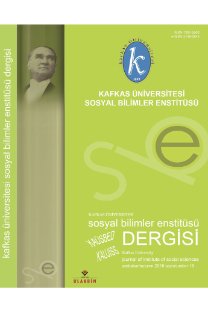Sekizinci Sınıf İngilizce Ders Kitabı Üzerine Derlem Temelli Çalışma
Yabancı dil ya da ikinci dil öğretiminde hedef dildeki derlemin dikkate alınması gerektiğinden dolayı, yabancı dil ders kitaplarında sözcük kullanımı yabancı dil öğrenenler için önem arz etmektedir. Belirlenen hedeflere ulaşmada dil öğrenenlere yardım etmek için; yabancı dil ders kitaplarının hedef dil derlemi dikkate alınarak hazırlanmış olması beklenmektedir. Bu çalışmanın amacı ilköğretim 8. sınıf İngilizce dersi için hazırlanan ders kitabındaki sözcüklerin hedef dil derlemi açısından uyguluğunu tartışmaktır. Aynı zamanda kitaptaki sözcüklerin Avrupa Dilleri Ortak Çerçeve Programındaki sözcük seçimi kıstaslarına uygunluğu tartışılmıştır. Bu çalışmadaki araştırma soruları şunlardır: 1. Ders kitabında en sık kullanılan sözcükler nelerdir? 2. İngilizce ’de en sık kullanılan 1000 sözcük, en sık kullanılan ikinci 1000 sözcük ve akademik sözcükler ders kitabında nasıl kullanılmıştır? 3. Ders kitabında kullanılan sözcükler, Avrupa Dilleri Ortak Çerçeve Programı A2 düzeyine uygun mudur? Bu çalışma yabancı dil öğretmenleri ve ders kitabı yazarlarına A2 düzeyine uygun sözcük seçiminde faydalı olacaktır.
A CORPUS ANALYSIS OF THE EIGHTH GRADERS’ TEXTBOOK
Vocabulary use in textbooks for foreign language learners is significant since national language corpus must be taken into account in teaching a language as a foreign or a second language. Textbooks are supposed to have been prepared by the corpus to help the foreign language learners to achieve desired level. This study aims at discussing the corpus in a textbook prepared for the eighth graders in Turkey. Besides it discusses how well it coincides with Common European Framework of Reference for Languages (CEFR). This study is based on the following questions: 1. What are the most frequent words in the textbook? 2. How well are K1 Words, K2 Words and Academic Words used in the textbook? 3. Does the corpus in the textbook coincide with A2 Level according to CEFR? The study will help not only foreign language learners but also school teachers and textbook writers in order to know and use basic vocabulary required for A2 Level according to the criteria of CEFR.
___
- Akbari, R. (2012). Vocabulary in L2 teaching: Some statistical findings. TESOL Arabia Perspectives, 19(2), 7-11.
- Bauer, L. & Nation, P. (1993), Word families. International Journal of Lexicography, Vol. 6 No. 4, 253-279.
- Council of Europe. (2001). Common European framework of reference for languages: Learning, teaching, assessment. Cambridge: Cambridge University Press.
- Genç, B. (2004). New trends in teaching and learning vocabulary. Çukurova University Journal of Social Sciences 13 (2), 117-126.
- Hunston, S. (2002). Corpora in applied linguistics. Cambridge: Cambridge University Press.
- Karatay, H. (2007). Kelime öğretimi. Gazi Eğitim Fakültesi Dergisi, Cilt 27, Sayı: 1, 141-153
- Laufer, B. (1986). Possible changes in attitude towards vocabulary acquisition. IRAL, 24(1), 69-75
- Meara, P. & Milton, J. (2003). X_Lex, the Swansea levels test. Newbury: Express. Michael F.
- G., Diane, A. & Jeannette, M. (2012). Teaching vocabulary to English language learners. New York, NY: Teachers College Press.
- Milton, J. & Alexiou, T. (2009). Vocabulary size and the Common European framework of reference for languages. In B. Richards et al. (Eds.), Vocabulary studies in first and second language acquisition (pp. 194–211). Basingstoke: Palgrave.
- Moghadam, H. S., Zainalb, Z. & Ghaderpourc, M. (2012). A review on the important role of vocabulary knowledge in reading comprehension performance. The 8th International Language for Specific Purposes (LSP) Seminar - Aligning Theoretical Knowledge with Professional Practice. Procedia - Social and Behavioral Sciences 66: 555 – 563.
- Nation, I. S. P. (2006). How large a vocabulary is needed for reading and listening. Canadian Modern Languages Review, 63(1)59-82.
- Nazary, M. (2008). The role of L1 in L2 acquisition: Attitudes of Iranian University students. Novitas-ROYAL, 2(2), 138 – 153
- O’Keeffe, A., McCarthy, M. & Carter, R. (2007). From corpus to classroom: Language use and language teaching. Cambridge: Cambridge University Press
- Rayson, P. (2002). Matrix: A statistical method and software tool for linguistic analysis through corpus comparison. Unpublished Ph.D. thesis. Computing Department, Lancaster University.
- Richards, J. C. (2001). Curriculum development in language teaching. Cambridge: Cambridge University Press.
- Römer, U. (2010). Using general and specialized corpora in English language teaching: Past, present and future. In: Campoy-Cubillo, M. et al. (eds.): Corpus- based approaches to English Language Teaching. London: Continuum, 18-38
- Schmitt, N. (2000). Vocabulary in language teaching. Cambridge, England: Cambridge University Press
- Thornbury, S. (2002), How to teach vocabulary. Harlow: Longman.
- Topkaraoğlu, M. & Dilman, H. (2015). The impact of vocabulary instruction on vocabulary size levels of students. Abant İzzet Baysal Üniversitesi Eğitim Fakültesi Dergisi, 15 (2), 349-363.
- Ünlü, F. (2012). Loading, distribution, and repetition patterns of the 2000 high frequency words of General English in an EFL course book. Unpublished MA Thesis. Department of English Language and Literature, Karadeniz Technical University.
- Van Ek, J. A. & Trim, J. L. M. (1990). Threshold 1990. Cambridge: Cambridge University Press
- Van Ek, J. A. & Trim, J. L. M. (1990). Waystage 1990. Cambridge: Cambridge University Press.
- Wallace, C. (2008). Vocabulary: The key to teaching English language learners to read. Education Digest. 73 (9), 36-39
- Waring, R. & Nation, P. (1997). Vocabulary size, text coverage, and word lists. In Vocabulary: Description, Acquisition and Pedagogy N. Schmitt and M. McCarthy (eds.). Cambridge University Press, Cambridge: 6-19.
- West, M. (1953). A general service list of English words. London: Longman, Green and Co.
- White, R. V. (1989). The ELT curriculum: Design, innovation and management. Cambridge: Blackwell.
- ISSN: 1307-5500
- Yayın Aralığı: 2
- Başlangıç: 2008
- Yayıncı: Kafkas üniversitesi Sosyal Bilimler Entitüsü
